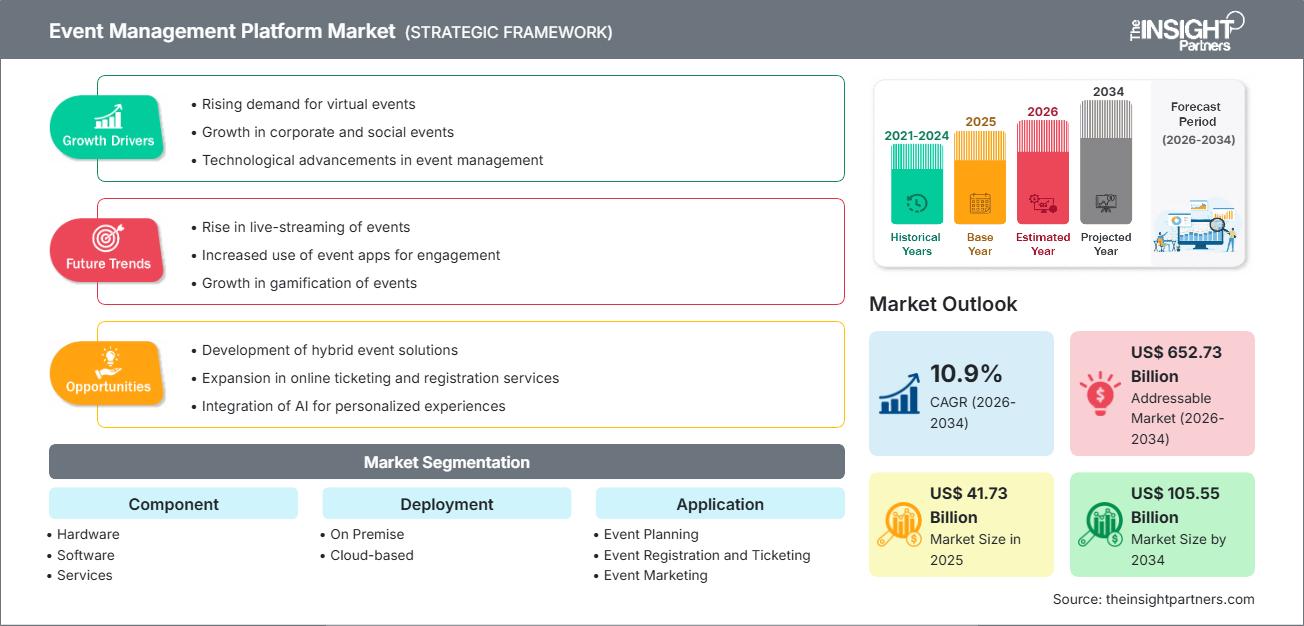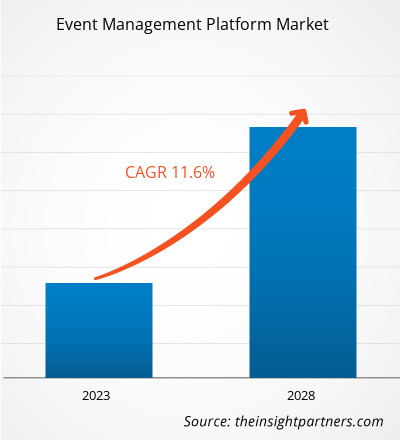Der Markt für Eventmanagement-Plattformen wird bis 2034 voraussichtlich ein Volumen von 105,55 Milliarden US-Dollar erreichen, gegenüber 41,73 Milliarden US-Dollar im Jahr 2025. Es wird erwartet, dass der Markt im Zeitraum 2026–2034 eine durchschnittliche jährliche Wachstumsrate (CAGR) von 10,9 % verzeichnen wird.
Marktanalyse für Eventmanagement-Plattformen
Der Markt für Eventmanagement-Plattformen wächst rasant. Treiber dieser Entwicklung sind die steigende Nachfrage nach hybriden und virtuellen Eventlösungen, die zunehmende Nutzung cloudbasierter Tools sowie die schnellen Fortschritte bei Echtzeitanalysen und KI-gestützter Automatisierung. Unternehmen nutzen diese Plattformen, um Events mühelos zu koordinieren, virtuelle Erlebnisse zu schaffen, Marketingmaßnahmen zu integrieren und ihre Teilnehmer zu verwalten. Die fortschreitende Digitalisierung, der Fokus auf Personalisierung von Events und die automatisierte Workflow-Optimierung fördern die Akzeptanz und das Wachstum dieses Marktes zusätzlich.
Marktübersicht Eventmanagement-Plattformen
Moderne Eventmanagement-Plattformen ermöglichen es Unternehmen, alle Aspekte der Eventplanung und -durchführung zu verwalten – von der Registrierung über die Teilnehmerverwaltung und Marketingautomatisierung bis hin zur Leistungsanalyse. Die Nutzung der Cloud bietet Planern Echtzeitzugriff, Mobilität und Flexibilität, während KI-gestützte Funktionen fortschrittliches Matchmaking, Content-Curation und umsetzbare Erkenntnisse ermöglichen. Diese Plattformen erlauben zudem eine verbesserte Integration mit CRM- und Marketing-Tools und unterstützen kanalübergreifende Promotionen und die Einbindung des Publikums in großem Umfang.
Passen Sie diesen Bericht Ihren Anforderungen an.
Sie erhalten eine kostenlose Anpassung aller Berichte – einschließlich Teilen dieses Berichts, Länderanalysen und Excel-Datenpaketen – sowie attraktive Angebote und Rabatte für Start-ups und Universitäten.
Markt für Eventmanagement-Plattformen: Strategische Einblicke

-
Ermitteln Sie die wichtigsten Markttrends dieses Berichts.Diese KOSTENLOSE Probe beinhaltet eine Datenanalyse, die von Markttrends bis hin zu Schätzungen und Prognosen reicht.
Markttreiber und Chancen für Eventmanagement-Plattformen
Markttreiber:
- Steigende Nachfrage nach Hybrid-Events: Das Wachstum von Hybrid-Events, also einer Kombination aus Präsenz- und virtueller Teilnahme, beeinflusst direkt die Nutzung ausgefeilter Eventmanagement-Plattformen, die beide Formen problemlos handhaben können.
- Automatisierungsanforderung: Gefragt ist eine Event-Organisationsplattform, die wichtige Prozesse wie Registrierung, Ticketing, Terminplanung und Kommunikation mit den Teilnehmern automatisieren kann, um so den manuellen Aufwand zu reduzieren, Fehler zu minimieren und die betriebliche Effizienz zu steigern.
- Datengestützte Entscheidungsfindung: Da Veranstaltungen immer größer werden, wird der Einsatz von Analysen zum Verständnis des Verhaltens, der Präferenzen und der Interaktionsmuster der Teilnehmer entscheidend, um den ROI zu maximieren und zukünftige Veranstaltungen effektiver zu planen.
- Cloud-Skalierbarkeit: Cloudbasierte Eventmanagement-Lösungen bieten skalierbare, flexible und zugängliche Plattformen, die schnell aktualisiert werden können, sodass Organisatoren Veranstaltungen aus der Ferne verwalten und große, verteilte Zielgruppen effizient unterstützen können.
Marktchancen:
- KI-gestützte Personalisierung: Dank maßgeschneiderter Inhalte, Sitzungsempfehlungen und intelligenter Chatbots sorgt die KI-gestützte Personalisierung dafür, dass Ihre Teilnehmer ein wirklich personalisiertes Erlebnis erhalten. Dies führt zu mehr Engagement und Zufriedenheit und somit zu besseren Veranstaltungsergebnissen.
- Branchenspezifische Plattformen: Spezialisierte Event-Plattformen für Unternehmen aus den Bereichen Wirtschaft, Bildung, MICE oder Unterhaltung können auf besondere betriebliche Anforderungen eingehen und maßgeschneiderte Funktionen für spezifische Veranstaltungsarten bieten.
- Integration mit CRM-/Marketing-Tools: Durch die engere Integration von Event-Plattformen mit CRM, Marketing-Automatisierung und Analysen erhalten Unternehmen die Möglichkeit, einheitliche Arbeitsabläufe zu erstellen, die Komplexität der Kommunikation zu reduzieren und umsetzbare Erkenntnisse zu gewinnen.
Marktbericht: Segmentierungsanalyse für Eventmanagement-Plattformen
Der Marktanteil von Eventmanagement-Plattformen wird in verschiedenen Segmenten analysiert, um ein besseres Verständnis seiner Struktur, seines Wachstumspotenzials und der aufkommenden Trends zu ermöglichen. Nachfolgend ist der in den meisten Branchenberichten verwendete Standard-Segmentierungsansatz dargestellt:
Nach Komponente:
- Hardware
- Software
- Dienstleistungen
Nach Einsatzart:
- Vor Ort
- Cloud-basiert
Auf Antrag:
- Veranstaltungsplanung
- Veranstaltungsregistrierung und Ticketverkauf
- Eventmarketing
- Inhaltsverwaltung
- Netzwerkmanagement
- Analyse und Berichterstattung
- Zielgruppenmanagement und Kommunikation
- Besuchermanagement
- Veranstaltungsmanagement
- Virtuelles LobManagement
Vom Endbenutzer:
- Messeveranstalter
- Eventmanagement-Agenturen
- Unternehmen
- Akademiker
- Organisationen
- Verbände/Gemeinnützige Stiftungen/Regierungsstellen
Nach Geographie:
- Nordamerika
- Europa
- Asien-Pazifik
- Lateinamerika
- Naher Osten und Afrika.
Markt für Eventmanagement-Plattformen: Regionale Einblicke
Die regionalen Trends und Einflussfaktoren auf den Markt für Eventmanagement-Plattformen im gesamten Prognosezeitraum wurden von den Analysten von The Insight Partners eingehend erläutert. Dieser Abschnitt behandelt außerdem die Marktsegmente und die geografische Verteilung des Marktes für Eventmanagement-Plattformen in Nordamerika, Europa, Asien-Pazifik, dem Nahen Osten und Afrika sowie Süd- und Mittelamerika.
Marktberichtsumfang für Eventmanagement-Plattformen
| Berichtattribute | Details |
|---|---|
| Marktgröße im Jahr 2025 | 41,73 Milliarden US-Dollar |
| Marktgröße bis 2034 | 105,55 Milliarden US-Dollar |
| Globale durchschnittliche jährliche Wachstumsrate (2026 - 2034) | 10,9 % |
| Historische Daten | 2021-2024 |
| Prognosezeitraum | 2026–2034 |
| Abgedeckte Segmente |
Nach Komponente
|
| Abgedeckte Regionen und Länder |
Nordamerika
|
| Marktführer und wichtige Unternehmensprofile |
|
Marktdichte der Eventmanagement-Plattformen: Auswirkungen auf die Geschäftsdynamik verstehen
Der Markt für Eventmanagement-Plattformen wächst rasant, angetrieben durch die steigende Nachfrage der Endnutzer. Gründe hierfür sind unter anderem sich wandelnde Verbraucherpräferenzen, technologische Fortschritte und ein wachsendes Bewusstsein für die Vorteile der Produkte. Mit steigender Nachfrage erweitern Unternehmen ihr Angebot, entwickeln innovative Lösungen, um den Kundenbedürfnissen gerecht zu werden, und nutzen neue Trends, was das Marktwachstum zusätzlich beflügelt.

- Verschaffen Sie sich einen Überblick über die wichtigsten Akteure im Markt für Eventmanagement-Plattformen.
Marktanteilsanalyse von Eventmanagement-Plattformen nach Regionen
Nordamerika trug maßgeblich zum weltweiten Umsatz bei und verzeichnet dank frühzeitiger Technologieeinführung, etablierter Firmenzentralen und ausgereifter Sponsoringmärkte weiterhin die höchsten absoluten Ausgaben. Der asiatisch-pazifische Raum weist das schnellste Wachstum auf, unterstützt durch eine flächendeckende 5G-Abdeckung, stark steigende digitale Zahlungen und staatlich geförderte Smart-City-Programme. Die Region lockte 2,5 Millionen Zuschauer zu einer einzigen 5G-fähigen Kinoübertragung und verdeutlichte damit das durch zuverlässige HD-Streams erschlossene, bisher ungenutzte Publikumspotenzial (GSMA).
Der Markt für Eventmanagement-Plattformen weist aufgrund von Faktoren wie Technologie in den einzelnen Regionen unterschiedliche Wachstumsverläufe auf, wobei Eventmanagement-Software über starke Datenverarbeitungsfunktionen verfügt. Nachfolgend finden Sie eine Zusammenfassung der Marktanteile und Trends nach Regionen:
-
Nordamerika
- Besitzt den größten Marktanteil, angetrieben durch die hohe Digitalisierungsrate und die Präsenz etablierter Event-Tech-Unternehmen.
- Starke Treiber: Investitionen führender Organisationen in die digitale Transformation von Konferenzen, Messen und hybriden Veranstaltungen.
- Trends: Fortschrittliche virtuelle Plattformen, tiefgreifende Analysen und Integration mit Unternehmenssoftware.
-
Europa
- Signifikantes Wachstum, angetrieben durch digitale Events, die Einhaltung regulatorischer Vorgaben und eine ausgeprägte Unternehmensveranstaltungskultur.
- Treiber: Einsatz im Bildungsbereich, auf Konferenzen und Messen; Schwerpunkt auf Datenschutz und Barrierefreiheit.
- Trends: Grüne und nachhaltige Eventlösungen, mehrsprachige Plattformfunktionen.
-
Asien-Pazifik
- Die am schnellsten wachsende Region, angetrieben durch die rasante digitale Transformation, die zunehmende Nutzung mobiler Geräte und ein wachsendes Ökosystem von KMU und Startups.
- Treiber: Staatlich geförderte Digitalisierung, massives Bevölkerungswachstum und steigende Nachfrage nach automatisierten Eventplanungstools.
- Trends: Einsatz von KI für die Teilnehmerzusammenstellung, mobile Lösungen und rasante Zunahme der Nutzung von Event-SaaS.
-
Lateinamerika
- Die Akzeptanz wird durch Firmenveranstaltungen, ein wachsendes unternehmerisches Ökosystem und die Nachfrage nach kostengünstigen, cloudbasierten Plattformen vorangetrieben.
- Trends: Lokalisierung von Apps, Integration sozialer Medien und Unterstützung virtueller/hybrider Veranstaltungen.
-
Naher Osten und Afrika
- Aufstrebende Region mit Wachstum in wichtigen Märkten – angetrieben durch Investitionen in Gastgewerbe, Tourismus und Großveranstaltungen.
- Trends: Regierungsinitiativen, Unterstützung für Großkonferenzen und Messen sowie digitale Innovationen im Veranstaltungssektor.
Marktdichte der Eventmanagement-Plattformen: Auswirkungen auf die Geschäftsdynamik verstehen
Der Markt für Eventmanagement-Plattformen ist durch den verstärkten Wettbewerb zwischen großen globalen Technologieanbietern und aufstrebenden Nischenanbietern sowie spezialisierten Startups geprägt. Unternehmen investieren aktiv in Innovationen, um ihre Marktposition zu stärken und die wachsende Nachfrage nach intelligenten Entscheidungsplattformen branchenübergreifend zu decken.
Der Wettbewerb zwingt die Anbieter dazu, sich durch Folgendes zu differenzieren:
- Durchgängige Planungsökosysteme, die Registrierung, Ticketing und virtuelle Bühnen integrieren.
- Skalierbare Cloud-Architekturen für globale Veranstaltungen und große Teilnehmerzahlen.
- Integriertes Marketing, Reporting und KI für umsetzbare Erkenntnisse, Networking und Optimierung.
Chancen und strategische Schritte
- Hochgradig personalisierte Teilnehmererlebnisse und -interaktion durch KI-gesteuerte Automatisierung.
- Erweiterung der Plattformfunktionen durch Partnerschaften oder Akquisitionen – insbesondere für die Integration von Funktionen für virtuelle Veranstaltungen, Datenanalysen und CRM-Anbindung.
- Investitionen in mobile Eventlösungen, Nachhaltigkeit und barrierefreies Design.
Wichtige Unternehmen, die auf dem Markt für Eventmanagement-Plattformen tätig sind
- ACTIVE NETWORK, LLC
- AirMeet
- AVENTRI, INC.
- BIGMARKER
- BIZZABO, INC.
- GOLDCAST
- PHEEDLOOP
- SOCIO
- SWAPARD
Neuigkeiten und aktuelle Entwicklungen auf dem Markt für Eventmanagement-Plattformen
- Am 30. September 2025 gaben Swapcard, eine führende Plattform für Event-Engagement, und Freeman, ein weltweit führendes Unternehmen im Bereich Live-Events, eine strategische Partnerschaft bekannt, um Veranstaltern eine vollständig integrierte Lösung für virtuelle, hybride und Präsenzveranstaltungen anzubieten.
- Am 10. September 2025 gab Financial Narrative, die globale Mitglieder-Community für leitende Finanzmarketing- und Storytelling-Experten, beispielsweise eine Partnerschaft mit Goldcast, der KI-gestützten Videocontent-Plattform, bekannt. Goldcast wird Financial Narrative als Partner für virtuelle Veranstaltungen unterstützen, das virtuelle Programm der Organisation ermöglichen und die Reichweite ihrer Präsenzveranstaltungen erweitern.
- Zum Beispiel hat Goldcast, die KI-gestützte Videocontent-Plattform für B2B-Vermarkter, am 3. September 2025 auf der AI Marketing School, die gemeinsam mit der AI Marketing Alliance veranstaltet wurde, ihre agentenbasierte Produktvision und die Beta-Verfügbarkeit ihrer ersten agentenbasierten Lösungen (weitere sind in Entwicklung) vorgestellt.
- Beispielsweise unterstützt Bizzabo, das Betriebssystem für Event-Erlebnisse, Marketingfachleute am 15. Juli 2025 dabei, besondere Momente in messbare Geschäftserfolge zu verwandeln. Dank der rekordverdächtigen Nutzung kleinerer, wirkungsvoller Events, intelligenterer Registrierungsprozesse und der branchenführenden Anerkennung durch Gartner und Forrester ebnet Bizzabo den Weg für die nächste Ära des Erlebnismarketings.
Marktbericht über Eventmanagement-Plattformen: Abdeckung und Ergebnisse
Der Bericht „Marktgröße und Prognose für Eventmanagement-Plattformen (2021–2034)“ bietet eine detaillierte Analyse des Marktes und deckt folgende Bereiche ab:
- Marktgröße und Prognose für Eventmanagement-Plattformen auf globaler, regionaler und Länderebene für alle wichtigen Marktsegmente, die im Rahmen des Berichts abgedeckt werden
- Markttrends für Eventmanagement-Plattformen sowie Marktdynamiken wie Treiber, Hemmnisse und wichtige Chancen
- Detaillierte PEST- und SWOT-Analyse
- Marktanalyse für Eventmanagement-Plattformen: Wichtige Markttrends, globale und regionale Rahmenbedingungen, Hauptakteure, regulatorische Bestimmungen und aktuelle Marktentwicklungen
- Branchenlandschaft und Wettbewerbsanalyse mit Marktkonzentration, Heatmap-Analyse, führenden Anbietern und aktuellen Entwicklungen im Markt für Eventmanagement-Plattformen. Detaillierte Unternehmensprofile.
- Historische Analyse (2 Jahre), Basisjahr, Prognose (7 Jahre) mit CAGR
- PEST- und SWOT-Analyse
- Marktgröße Wert/Volumen – Global, Regional, Land
- Branchen- und Wettbewerbslandschaft
- Excel-Datensatz
Aktuelle Berichte
Erfahrungsberichte
Grund zum Kauf
- Fundierte Entscheidungsfindung
- Marktdynamik verstehen
- Wettbewerbsanalyse
- Kundeneinblicke
- Marktprognosen
- Risikominimierung
- Strategische Planung
- Investitionsbegründung
- Identifizierung neuer Märkte
- Verbesserung von Marketingstrategien
- Steigerung der Betriebseffizienz
- Anpassung an regulatorische Trends






















 Kostenlose Probe anfordern für - Markt für Eventmanagement-Plattformen
Kostenlose Probe anfordern für - Markt für Eventmanagement-Plattformen